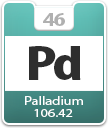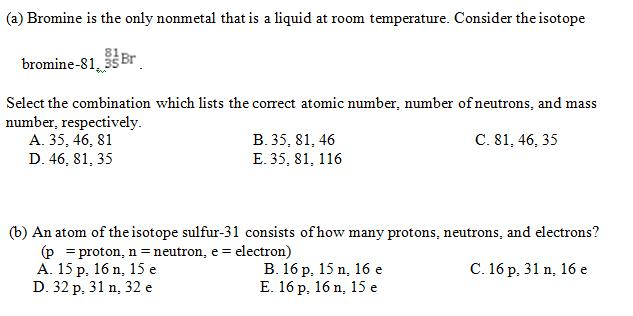Palladium is a chemical element with symbol Pd and atomic number 46. Classified as a transition metal, Palladium is a solid at room temperature. Chemical elements listed by atomic number The elements of the periodic table sorted by atomic number. Click on any elements name for further chemical properties, environmental data or health effects. This list contains the 118 elements of chemistry.
The Element Palladium
[Click for Isotope Data]
Atomic Number: 46
Atomic Weight: 106.42
Melting Point: 1828.05 K (1554.9°C or 2830.8°F)
Boiling Point: 3236 K (2963°C or 5365°F)
Density: 12.0 grams per cubic centimeter
Phase at Room Temperature: Solid
Element Classification: Metal
Period Number: 5
Group Number: 10
Group Name: none

What's in a name? Named for the asteroid Pallas and the Greek goddess of wisdom.


Say what? Palladium is pronounced as peh-LAY-dee-em.
History and Uses:
Palladium was discovered by William Hyde Wollaston, an English chemist, in 1803 while analyzing samples of platinum ore that were obtained from South America. Although it is a rare element, palladium tends to occur along with deposits of platinum, nickel, copper, silver and gold and is recovered as a byproduct of mining these other metals.
Palladium is used to make springs for watches, surgical instruments, electrical contacts and dental fillings and crowns. Finely divided palladium acts as a catalyst and is used in hydrogenation and dehydrogenation processes. Palladium at room temperature can absorb up to 900 times its own volume of hydrogen. Hydrogen will easily pass through heated palladium, a property that allows for the easy purification of hydrogen. Palladium alloys are used to make jewelry and, when alloyed with gold, forms a material known as white gold.
Palladium dichloride (PdCl2), a palladium compound, can absorb large amounts of carbon monoxide (CO) gas and is used in carbon monoxide detectors.
Estimated Crustal Abundance: 1.5×10-2 milligrams per kilogram
Estimated Oceanic Abundance: Not Applicable
Atomic Number List
Number of Stable Isotopes: 6 (View all isotope data)
Ionization Energy: 8.337 eV
Oxidation States: +3, +2
Electron Shell Configuration: | 1s2 |
2s2 2p6 | |
3s2 3p6 3d10 | |
4s2 4p6 4d10 |
For questions about this page, please contact Steve Gagnon.
In the modern periodic table, the elements are listed in order of increasing atomic number. The atomic number is the number of protons in the nucleus of an atom. The number of protons define the identity of an element (i.e., an element with 6 protons is a carbon atom, no matter how many neutrons may be present). The number of protons determines how many electrons surround the nucleus, and it is the arrangement of these electrons that determines most of the chemical behavior of an element.
Chemical Element Of Atomic Number 46
In a periodic table arranged in order of increasing atomic number, elements having similar chemical properties naturally line up in the same column (group). For instance, all of the elements in Group 1A are relatively soft metals, react violently with water, and form 1+ charges; all of the elements in Group 8A are unreactive, monatomic gases at room temperature, etc. In other words, there is a periodic repetition of the properties of the chemical elements with increasing mass.
Atomic Number 46 Abbreviation
In the original periodic table published by Dimitri Mendeleev in 1869, the elements were arranged according to increasing atomic mass— at that time, the nucleus had not yet been discovered, and there was no understanding at all of the interior structure of the atom, so atomic mass was the only guide to use. Once the structure of the nucleus was understood, it became clear that it was the atomic number that governed the properties of the elements.




